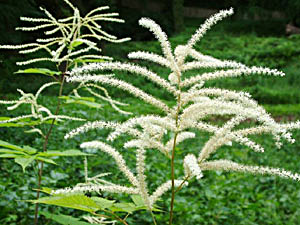
medicinal herbs
Goat's Beard
Aruncus dioicus

Herb: Goat's Beard
Latin name: Aruncus dioicus
Synonyms: Aruncus sylvester, Aruncus vulgaris
Family: Rosaceae (Rose Family)
Medicinal use of Goat's Beard:
The poulticed root is applied to bee stings. A tea made from the roots is used to allay bleeding after child birth, to reduce profuse urination and to treat stomach pains, diarrhoea, gonorrhoea, fevers and internal bleeding. The tea is used externally to bathe swollen feet and rheumatic joints. A salve made from the root ashes is rubbed onto sores.Description of the plant:

Plant:
Perennial
Height:
2 m(6 1/2 foot)

Flowering:
June toAugust

Scent:
ScentedPerennial
Habitat of the herb:
Damp woods, shady places and by streams, usually in mountainous areas.Edible parts of Goat's Beard:
Budlings, stems and young leaves - cooked. Some caution is advised, see the notes above on toxicity.Other uses of the herb:
Plants form a dense growth that is very effective at holding invasive plants at bay. They can be used as a tall ground cover for large areas.Propagation of Goat's Beard:
Seed - best sown in a cold frame as soon as it is ripe. Sow stored seed in late winter or early spring in a cold frame. When large enough to handle, prick the seedlings out into individual pots and grow them on in a cold frame until they are at least 15cm tall. They can be planted out into their permanent positions at any time of the year. Division in early spring or autumn. Very easy, the clumps can be planted out direct into their permanent positions.Cultivation of the herb:
Damp woods, shady places and by streams, usually in mountainous areas.Known hazards of Aruncus dioicus:
Cyanogenic glycosides are found in the leaves.Plant information taken from the Plants For A Future.
